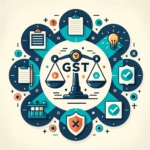How the Supreme Court Interprets GST Laws: Case Analysis
Have you ever stared at a GST notice, completely baffled by the jargon and the demands from the tax department? Or perhaps you’ve struggled to claim an input tax credit that you were sure you were entitled to. If you’re a small business owner in India, these scenarios are all too familiar. The Goods and Services Tax (GST) was a game-changer, but its complexity often leads to confusion and disputes. When these disagreements escalate, the final word comes from the highest court in the land. Understanding how the Supreme Court interprets laws, particularly a complex one like GST, is not just an academic exercise—it directly impacts your business’s finances and compliance strategy. This article will break down this crucial topic, analyzing key principles and landmark Supreme Court judgments on laws Indian context to show you what these high-level decisions mean for your day-to-day operations.
Understanding the GST Framework and the Court’s Role
Before diving into complex legal interpretations, it’s essential to have a clear picture of the GST system and why the Supreme Court’s role is so vital. The GST is not a single tax but a comprehensive system designed to streamline India’s indirect tax structure. For any business, understanding its basic components is the first step towards compliance and avoiding disputes. Similarly, appreciating the judiciary’s function helps contextualize why a single court ruling from Delhi can affect a small shop in a different state. The court acts as a referee, ensuring that the rules of the game are applied fairly to both the tax authorities and the taxpayers, creating a stable and predictable economic environment for everyone involved.
A Quick GST Refresher for Business Owners
At its core, GST is a destination-based tax on the consumption of goods and services. To simplify its administration across the country, it is structured into a few key components:
- CGST (Central GST): This is the portion of the tax collected by the Central Government on a sale that happens within a state (an intra-state transaction).
- SGST (State GST): This is the tax collected by the State Government on that same intra-state sale. For example, if you sell a product from Pune to Mumbai, both CGST and SGST will apply.
- IGST (Integrated GST): This tax is collected by the Central Government when a sale happens between two different states (an inter-state transaction). For instance, a sale from Delhi to Bangalore would attract IGST.
A crucial concept within this framework is the Input Tax Credit (ITC). In simple terms, ITC allows you to reduce the tax you pay on your sales (output tax) by the amount of tax you have already paid on your purchases (input tax). This mechanism is the backbone of GST, designed to prevent the “tax on tax” effect and ensure the burden is passed seamlessly through the supply chain until it reaches the final consumer. For businesses, managing ITC correctly is fundamental to maintaining healthy cash flow and profitability.
Why Legal Interpretation by the Supreme Court Matters
When there is ambiguity or a dispute over how a specific GST rule should be applied, the matter can eventually reach the courts. The Supreme Court of India sits at the apex of this judicial system. Its role is not just to settle the dispute between the two parties in a case but to provide a definitive legal interpretation Supreme Court India that clarifies the law for the entire country. This power stems from the principle of ‘judicial review,’ which allows courts to ensure that laws passed by the legislature and actions taken by the government are constitutional and fair.
Furthermore, the Indian legal system operates on the principle of stare decisis, a Latin term that means “to stand by things decided.” This means that a decision made by the Supreme Court becomes a binding precedent. All lower courts, tribunals, tax authorities, and even taxpayers across India must follow this ruling. This is why understanding how the Supreme Court interpretation of laws India works is so critical. A single judgment can redefine compliance requirements, open up new avenues for tax claims, or close existing loopholes, setting a new “law of the land.” For foundational information on GST, taxpayers can always refer to the official GST Portal.
How the Supreme Court Interprets Laws: Key Principles in GST
When the Supreme Court is faced with a complex tax case, it doesn’t just make a random decision. It employs a set of well-established principles of legal interpretation to arrive at a just and logical conclusion. These principles act as a toolkit for judges to decipher the true meaning and intent of the law. Understanding these methods helps businesses appreciate the reasoning behind a judgment and even anticipate how future disputes might be resolved. For GST, which is a relatively new and evolving law, these interpretive principles are frequently used to address novel issues that were not explicitly foreseen when the law was written.
The Literal Rule: Reading the Law as It Is Written
The first and most straightforward principle is the Literal Rule. The court’s initial approach is to read the words of the law and give them their natural, ordinary, and grammatical meaning. The assumption is that Parliament chose its words carefully and intended for them to be understood as they are written. For example, if a GST provision states that tax is applicable on the “supply of goods,” the court will first interpret “goods” based on its standard definition in the GST Act. It will not look for a hidden or deeper meaning unless the literal interpretation leads to an absurd or unjust outcome. This rule provides certainty and predictability, as taxpayers can generally rely on the plain text of the law for their compliance activities.
The Purposive Approach: Understanding the “Why” Behind the Law
Sometimes, the literal meaning of a law can be ambiguous or lead to a result that contradicts the overall objective of the legislation. In such situations, the Supreme Court uses the Purposive Approach. Here, judges look beyond the specific words and try to understand the purpose, or the “mischief,” that Parliament was trying to remedy by enacting that law. For GST, the overarching purpose was to create a unified national market, simplify indirect taxation, and reduce cascading taxes. When a provision is unclear, the court will often favor an interpretation that aligns with these broader goals. This approach allows the law to be applied more flexibly and sensibly to new and unforeseen situations, ensuring that the spirit of the law is upheld, not just the letter.
Balancing Taxpayer Rights with Government Revenue
Tax law, by its nature, involves a constant tension between the government’s need to collect revenue for public services and the taxpayer’s right to be taxed fairly and not arbitrarily. The Supreme Court often plays the crucial role of a balancing authority. It ensures that tax authorities do not overstep their powers or interpret laws in a way that is oppressive to taxpayers. At the same time, it prevents taxpayers from using legal loopholes to evade legitimate taxes. This balancing act is evident in many GST judgments, providing a crucial layer of protection for citizens. This context is essential for any case law analysis Supreme Court India, as it often reveals the court’s effort to strike a fair equilibrium between two competing but equally important interests.
Landmark GST Case Analysis: What They Mean for You
Theoretical principles come to life when we examine how they are applied in real-world cases. The Supreme Court has delivered several landmark judgments on GST that have had a profound impact on businesses across India. Analyzing these cases helps us understand the court’s thought process and provides concrete lessons for compliance. These decisions are not just legal victories or losses for the parties involved; they set precedents that shape the entire GST landscape and are among the Key GST Judgments Every Business Should Know.
Case Study 1: Union of India v. Mohit Minerals Pvt. Ltd. (The Ocean Freight Case)
- The Dispute: The central issue in this high-profile Supreme Court case analysis India was whether importers were liable to pay IGST on ocean freight charges. Importers were already paying customs duty, which included the cost of freight. The government, through a notification, levied IGST on these freight services again, arguing it was a separate supply. The importers contended that this was a form of “double taxation,” as the value of freight was already part of the goods’ value on which they paid tax.
- The Supreme Court’s Ruling: The Supreme Court ruled in favor of the importers, holding that the levy of IGST on ocean freight was unconstitutional. The court found that the import transaction was a “composite supply” where the main supply is the goods themselves, and services like freight are naturally bundled. Since the value of freight was already included in the assessable value of the imported goods for calculating IGST, levying a separate tax on it was not permissible. More importantly, the court made a groundbreaking observation: the recommendations of the GST Council are not binding on the Union and State legislatures. They have a persuasive value, but governments are not mandated to implement them.
- Practical Impact for Your Business:
- This judgment provided direct financial relief to importers, who no longer have to pay this additional IGST, improving their cash flow.
- The ruling on the GST Council’s role is a monumental clarification of India’s fiscal federalism. It establishes that while the Council is a key collaborative body, the ultimate law-making power rests with Parliament and State Assemblies. This has far-reaching implications for future GST policy and potential disputes.
Case Study 2: Union of India v. VKC Footsteps India Pvt Ltd (The ITC Refund Case)
- The Dispute: This case law analysis Supreme Court India dealt with the tricky issue of an “inverted duty structure.” This occurs when the GST rate on inputs (raw materials) is higher than the rate on the final outputs (finished products). For example, a footwear manufacturer might pay 12% GST on raw materials but only collect 5% GST on the finished shoes. This leads to an accumulation of unutilized Input Tax Credit. The law allowed for a cash refund of this excess credit, but the dispute was whether this refund should include ITC on input services (like rent, marketing, professional fees), a topic detailed in our guide on ITC on Services: Eligibility and Documentation Requirements, or only on input goods.
- The Supreme Court’s Ruling: The Supreme Court upheld the government’s formula, which restricts the refund to unutilized ITC paid on input goods only. The court reasoned that the law makes a clear distinction between “goods” and “services” and that the formula prescribed by the government was not arbitrary or unconstitutional. It acknowledged the anomaly but stated that it was a matter of legislative policy, and the court could not expand the scope of the refund provision beyond what the law explicitly allowed.
- Practical Impact for Your Business:
- Businesses operating under an inverted duty structure, common in sectors like textiles, footwear, and certain manufacturing, are directly affected. They cannot claim a cash refund for the GST paid on their input services.
- This decision impacts financial planning and cash flow management for these businesses. The unutilized ITC on services becomes a cost, potentially affecting pricing and profitability. It underscores the importance of precise business planning in these specific industries.
Practical Takeaways for GST Compliance
Understanding Supreme Court judgments is not just for lawyers and chartered accountants. The principles and outcomes from these cases offer practical lessons for every business owner striving for seamless GST compliance. Being proactive and informed can save you from costly disputes, penalties, and unnecessary stress, allowing you to focus on growing your business.
Stay Informed, Stay Compliant
The legal landscape of GST is constantly evolving, with new notifications, circulars, and court rulings being issued regularly. It is crucial for business owners to stay updated on significant developments, especially landmark judgments from the Supreme Court.
- Follow reliable sources: Keep track of updates from reputable financial news portals and professional publications.
- Consult professionals: Regularly discuss changes in the law with your tax advisor to understand how they affect your specific business.
- Remember: Ignorance of the law, including new interpretations established by courts, is never considered a valid defense in a tax dispute.
The Importance of Documentation
If there is one golden rule in taxation, it is to maintain meticulous records. In any tax assessment or dispute, your documentation is your first and strongest line of defense. As highlighted in our article on The Importance of Accurate Record-Keeping to Prevent GST Demand Notices, the Supreme Court cases often turn on the evidence presented, which is built on proper paperwork.
- Keep everything: Maintain organized records of all your sales invoices, purchase bills, e-way bills, ITC registers, and payment receipts.
- Reconcile regularly: Ensure your accounting records match your GST returns (GSTR-1, GSTR-3B) and your bank statements. This helps catch discrepancies early.
- Be prepared: Well-maintained documents can quickly clarify issues raised by tax authorities and demonstrate your compliance in good faith.
When to Seek Expert Help
While it’s good to be informed, the nuances of tax law can be incredibly complex. Trying to navigate a GST notice or a complex transaction on your own can lead to costly mistakes. Knowing when to call in a professional is a sign of a smart business owner.
- Don’t delay: If you receive a notice or summons from the GST department, contact a tax expert immediately.
- Clarify doubts: Before entering into a large or unusual business transaction, consult an advisor to understand its GST implications.
- Strategic guidance: Experts can provide strategic advice on structuring your business operations for optimal GST efficiency and compliance. If you need assistance, consider leveraging professional guidance from TaxRobo’s GST Services.
Conclusion
The world of GST can seem like a complex maze, but the judgments of the Supreme Court of India act as a guiding light, providing clarity and direction. We’ve seen how the court, as the final arbiter, uses established principles to resolve critical disputes. The Mohit Minerals case gave importers significant relief and clarified the non-binding nature of GST Council recommendations, while the VKC Footsteps case provided a definitive answer on ITC refunds for businesses with an inverted duty structure. These rulings have tangible, real-world consequences, affecting everything from your tax liability to your business strategy. For any business owner, understanding how the Supreme Court interprets laws is no longer a choice; it’s a fundamental part of achieving robust, risk-free, and intelligent GST compliance in India.
Navigating GST and its evolving legal landscape can be daunting. If you need expert guidance on GST registration, filing, or compliance strategy based on the latest legal precedents, Contact the TaxRobo team today for a consultation.
Frequently Asked Questions (FAQs)
Q1: Are the recommendations of the GST Council legally binding on my business?
A: No. As clarified by the Supreme Court in the Mohit Minerals case, the GST Council’s recommendations have persuasive value but are not legally binding on State and Union legislatures. Therefore, they are not binding on taxpayers unless they are officially enacted as law through a notification or an amendment to the GST Acts.
Q2: I run a manufacturing business with an inverted duty structure. Can I claim a GST refund on services like rent or marketing?
A: Based on the VKC Footsteps judgment, the Supreme Court has upheld the rule that currently restricts cash refunds under an inverted duty structure to the tax paid on input goods only. You cannot claim a refund for the accumulated ITC on input services.
Q3: How is a High Court ruling on GST different from a Supreme Court ruling?
A: A High Court’s ruling is binding only within its own state’s jurisdiction. For example, a judgment from the Bombay High Court is binding in Maharashtra but not necessarily in Karnataka. However, a Supreme Court interpretation of laws India is binding on all courts, tribunals, tax authorities, and citizens across the entire country, making it the supreme law of the land.
Q4: Where can I find the official text of these Supreme Court judgments?
A: You can access official judgments directly from the Supreme Court of India’s website. The website has a searchable database where you can find the full text of judgments by entering the case name, date, or other relevant details.



